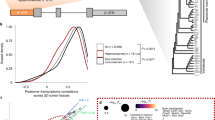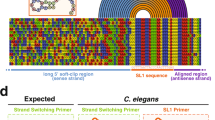Abstract
ALTHOUGH eukaryotic genes are usually transcribed individually, at least a few Caenorhabditis elegans genes appear to be transcribed polycistronically in clusters resembling bacterial operons1. The spliced leader SL2 (ref. 2) is specific for trans-splicing to downstream genes in these operons1. In addition, many C. elegans pre-mRNAs are trans-spliced to SL1 (ref. 3) near the 5′ ends of pre-mRNAs4,5. Because operons have not previously been found in higher eukaryotes, we have investigated how wide-spread they are in the C. elegans genome. We identified gene clusters using the extensive data generated by the genome project6,7 and tested seven for trans-splicing specificity. All were found to fit expectations for polycistronic transcription. In addition, we sur-veyed reported C. elegans genes for trans-splicing specificity. Both methods indicate that the pre-mRNAs of about 70% of C. elegans genes are trans-spliced and as many as a quarter are transcribed in operons.
This is a preview of subscription content, access via your institution
Access options
Subscribe to this journal
Receive 51 print issues and online access
$199.00 per year
only $3.90 per issue
Buy this article
- Purchase on SpringerLink
- Instant access to full article PDF
Prices may be subject to local taxes which are calculated during checkout
Similar content being viewed by others
References
Spieth, J., Brooke, G., Kuerston, S., Lea, K. & Blumenthal, T. Cell 73, 521–532 (1993).
Huang, X-Y. & Hirsh, D. Proc. natn. Acad. Sci. U.S.A. 86, 8640–8644 (1989).
Krause, M. & Hirsh, D. Cell 49, 753–761 (1987).
Conrad, R., Thomas, J., Spieth, J. & Blumenthal, T. Molec. cell. Biol. 11, 1921–1926 (1991).
Conrad, R., Liou, R. F. & Blumenthal, T. EMBO J. 12, 1249–1255 (1993).
Sulston, J. et al. Nature 356, 37–41 (1992).
Wilson, R. et al. Nature 368, 32–38 (1994).
Huang, L. S., Tzou, P. & Sternberg, P. W. Molec. Biol. Cell 5, 395–412 (1994).
Clark, S. G., Lu, X. & Horvitz, H. R. Genetics 137, 987–997 (1994).
Lee, Y. H., Huang, X-Y., Hirsh, D., Fox, G. E. & Hecht, R. M. Gene 121, 227–235 (1992).
Waterston, R. et al. Nature Genet. 1, 114–123 (1992).
Huang, X.-Y. et al. J. molec. biol. 206, 411–424 (1989).
Land, M., Islas-Trejo, A. & Rubin, C. S. J. biol. Chem. 259, 14820–14827 (1994).
Kuwabara, P. E., Okkema, P. G. & Kimble, J. Molec. Biol. Cell 3, 461–473 (1992).
Hu, E. & Rubin, C. S. J. biol. Chem. 266, 19796–19802 (1991).
Capowski, E. E., Martin, P., Garvin, C. & Strome, S. Genetics 129, 1061–1072 (1991).
Morgan, W. M. & Greenwald, I. Molec. cell. Biol. 13, 7133–7143 (1993).
Author information
Authors and Affiliations
Rights and permissions
About this article
Cite this article
Zorio, D., Cheng, N., Blumenthal, T. et al. Operons as a common form of chromosomal organization in C. elegans. Nature 372, 270–272 (1994). https://doi.org/10.1038/372270a0
Received:
Accepted:
Issue Date:
DOI: https://doi.org/10.1038/372270a0



